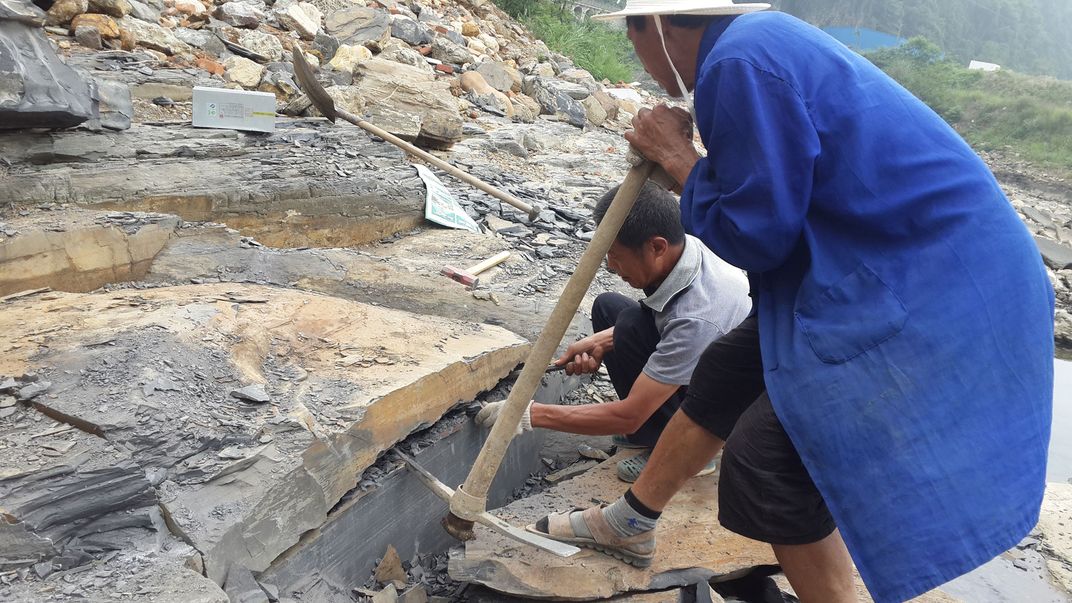Fossil Treasure Trove of Ancient Animals Unearthed in China
The fossils from the Cambrian Period include dozens of new species and provide a window into life more than 500 million years ago
/https://tf-cmsv2-smithsonianmag-media.s3.amazonaws.com/filer/37/e5/37e56b19-f04e-4884-9e2d-86059996f9d0/602p01g01burgess_shalew.jpg)
The Cambrian was a time of vibrant, wonderful life. Fossil-packed sites like the Burgess Shale in Canada have revealed the unique nature of early animals around 508 million years ago. The strange creatures found in the rock are so delicately preserved that the ancient deposit seemed like a rarity, showing the unusual appendages and body shapes of the time.
In the century since the Burgess Shale discovery, however, other fossil wonderlands of similar age have been uncovered elsewhere on the planet. The latest to be recognized was found in southern China: the Qingjiang Biota.
In a paper published today in the journal Science, Paleontologist Dongjing Fu of Xi’an’s Northwest University and colleagues describes the Cambrian Period fossils. At 518 million years old, the collection is about 10 million years older than the Burgess Shale. The way the fossils formed, however, is similar to those in North America. Visible in high contrast as dark fossils on gray stone, the organisms of the Qingjiang Biota are preserved down to the finest details. The fossils include trilobites, jellyfish, shrimp-like arthropods and even tadpole-like animals from the earliest days of the vertebrate family.
Dozens of these species have never been seen before. “What makes the Qingjaing special compared to other Cambrian sites with soft parts preserved, such as the Burgess Shale and Chengjiang Biota [in southern China], is the fact that there is over fifty percent entirely new taxa of animals and algae that are previously unknown to science,” says University of Lausanne paleontologist Allison Daley. Even better, she notes, is that the fossils are of “truly exceptional quality,” preserving the anatomy of the species without some of the natural distortions that sometimes result from the fossilization process.
/https://tf-cmsv2-smithsonianmag-media.s3.amazonaws.com/filer/50/92/5092cdf9-d99a-43cd-9109-f84d03cd75f4/f2large_1.jpg)
“It shows how we have these little windows back to the past and how finding another site can change what we know,” says University of Bristol paleontologist Jakob Vinther.
Some of the most beautiful specimens from the site are of soft-bodied creatures that don’t easily enter the geologic record. “The presence of so many stunning cnidarians was an absolute pleasure to see,” Daley says, referring to the jellyfish and sea anemones that thrived in this ancient ecosystem and are some of the key fossils that make the Qingjiang Biota stand out. “The significance of this site is in the way it fills several gaps in knowledge about key animal groups,” including cnidarians, strange invertebrates known as “mud dragons” and comb jellies. Representatives of all these groups are still alive today, making them some of the most ancient and successful animals in the world.
This wealth of squishy-bodied specimens hasn’t been visible at other Cambrian sites. “The diversity of cnidarians and ctenophores and sponges seems unique and therefore may give us a lot of clues to the origin and evolution of these groups that other sites couldn’t,” Vinther says.
The seeming flash fossilization of the Qingjiang Biota preserves an entire community of species, as close as paleontologists can get to time traveling back to 518 million years ago. “The fact that the assemblage of taxa is so different from other sites will also reveal the characteristics that influence what taxa live together in the same place at the same time,” Daley says, “and show us information about their ecological interactions.”
The Qingjiang Biota also adds a new wrinkle to the ongoing fossiliferous debate about the Cambrian explosion. The “explosion” was a dramatic diversification of life during the Cambrian Period, but paleontologists are still discussing whether the evolutionary event was a real, sudden change or if it simply looks that way because of incomplete fossil sampling. While the Qingjiang Biota doesn’t necessarily resolve the debate, Daley says, it adds to the picture of amazing evolutionary radiation during the Cambrian.

The fact that the Qingjiang Biota is about the same age as the nearby Chengjiang Biota, but contains many previously unknown species, indicates that the Cambrian hosted more unusual organisms than paleontologists previously imagined. The diversity of life at the time could be a signal of a much earlier flurry of evolutionary activity that gave rise to many new species preserved at sites like Qingjiang and the Burgess Shale.
The study by Dongjing Fu and colleagues is a preliminary report, announcing the discovery of many species that have yet to be named and intensively studied. There may be more fossils out there as well. The researchers note that the geologic formation in which the Qingjiang Biota resides is found in other places in China and could yield additional fossils.
The identities and interactions of the Qingjiang Biota creatures have yet to fully come into focus. For now, they offer a new window to a time we know little about, and, Daley says, “I can’t wait to see the detailed studies on these amazing fossils in the future.”
/https://tf-cmsv2-smithsonianmag-media.s3.amazonaws.com/accounts/headshot/RileyBlack.png)
/https://tf-cmsv2-smithsonianmag-media.s3.amazonaws.com/accounts/headshot/RileyBlack.png)